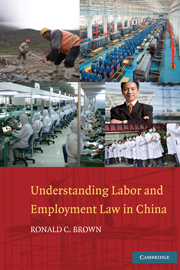Book contents
- Frontmatter
- Contents
- Preface
- Acknowledgments
- Understanding Labor and Employment Law in China
- PART I UNDERSTANDING CHINA'S REGULATION OF THE WORKPLACE
- PART II EMPLOYMENT RELATIONSHIPS
- PART III HIRING AND EMPLOYMENT PRACTICES
- PART IV WORKING CONDITIONS, WAGES, AND HOURS
- 8 Safety and Health Protection
- 9 Injury Compensation
- 10 Wages and Hours
- PART V EMPLOYEE BENEFITS: LEAVES, MEDICAL, MATERNITY, WORK-RELATED, UNEMPLOYMENT, AND PENSION INSURANCE
- PART VI DISCIPLINE AND TERMINATION UNDER EMPLOYMENT AGREEMENTS
- PART VII RIGHTS, REMEDIES, AND MULTIPLE FORUMS
- Appendix
- Index
- References
10 - Wages and Hours
Published online by Cambridge University Press: 22 January 2010
- Frontmatter
- Contents
- Preface
- Acknowledgments
- Understanding Labor and Employment Law in China
- PART I UNDERSTANDING CHINA'S REGULATION OF THE WORKPLACE
- PART II EMPLOYMENT RELATIONSHIPS
- PART III HIRING AND EMPLOYMENT PRACTICES
- PART IV WORKING CONDITIONS, WAGES, AND HOURS
- 8 Safety and Health Protection
- 9 Injury Compensation
- 10 Wages and Hours
- PART V EMPLOYEE BENEFITS: LEAVES, MEDICAL, MATERNITY, WORK-RELATED, UNEMPLOYMENT, AND PENSION INSURANCE
- PART VI DISCIPLINE AND TERMINATION UNDER EMPLOYMENT AGREEMENTS
- PART VII RIGHTS, REMEDIES, AND MULTIPLE FORUMS
- Appendix
- Index
- References
Summary
Minimum wages standards and guidelines are set out in the 2004 Regulations on Minimum Wage (RMW), which follow the 1994 Labor Law. The RMW specifies required wage payments, deductions, and overtime, though some issues occasionally arise regarding exempted categories of workers, such as managers. In addition, variations in coverage and wage levels occur as implementing standards are fixed and administered at local levels. Local governments are also primarily responsible for administration and enforcement, but aggrieved workers must bring their labor dispute to arbitration to recover unpaid wages. Unfortunately, the transition to a market economy has been accompanied by underpayment and nonpayment of wages to many workers, especially to migrant workers. Likewise, studies have shown that minimum wages, originally targeted at 40 to 60 percent of the average monthly wages, often fall below the 40 percent level. For example, in 2006 in Beijing, the level was reported to be at around 20 percent, creating a gap of nearly 600 yuan per month.
Societal Disparities
In the late 1980s, the economic developments following the Four Modernizations of 1979 produced workplaces that were increasingly regulated by labor contracts, replacing the “iron rice bowl” model of earlier years. The transition to a socialist market economy in the 1990s coincided with a growing assumption of managerial control by employers. Because of market forces, employers were forced to maximize profits if they hoped to survive without the government subsidies provided in the former planned economy, and lawmakers responded by allowing greater employer autonomy.
- Type
- Chapter
- Information
- Understanding Labor and Employment Law in China , pp. 125 - 132Publisher: Cambridge University PressPrint publication year: 2009

